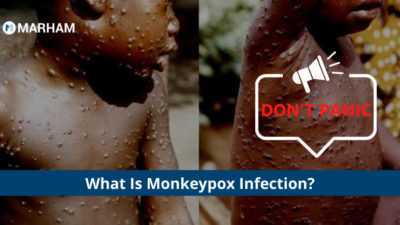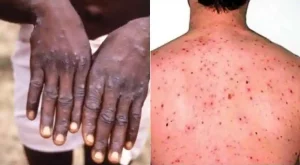Are you searching about monkeypox? Do you think it can be the next pandemic after COVID-19? If so, lets discus some of the facts about monkey pox, that can clear all the fears and misconceptions!
Monkeypox is a viral disease that was first seen in laboratory monkeys; hence, the name is monkeypox. The virus is not novel. The virus was discovered in 1958 among the monkeys under research. The disease is pox-like. The first case of monkeypox infection in humans was reported in 1970 in the Democratic Republic of the Congo.
The virus has two strains: one from Central Africa and one from West Africa that is less severe. The West African strain has been linked to recent monkeypox cases.
In past two decades, a few cases of monkeypox were reported. Most of them were in different regions of Africa. And in some people, who travelled to Nigeria, Congo, Ghana, Gabon, Liberia, etc.
Recent Monkeypox Outbreak:
The cause of recent outbreak of Monkeypox infection is still unknown. The cases appear in countries where no travel history has been reported to any country of origin of monkeypox. This outbreak is unexpected because cases have emerged in countries where the virus is rarely seen, such as Australia, Canada, and the United Kingdom, as well as other European countries.
According to the World Health Organization, there are currently over 111 confirmed cases and approximately 28 suspected cases of monkeypox in a dozen countries.
Monkeypox In Pakistan:
On Monday, Pakistan’s National Institute of Health (NIH) issued a monkeypox alert, as global health officials warned of rising cases of a type of viral infection more common in west and central Africa in Europe and elsewhere.
Some rumors are circulating on social media since yesterday about cases of monkeypox in Pakistan. But National Institute of Health of Pakistan clarifies that there is no confirmed case of monkeypox has yet been discovered in Pakistan. But the health authorities are monitoring the situation very keenly and all the health departments are on high alert.
Monkeypox Virus Infection:
Monkeypox is a viral zoonotic disease that primarily occurs in tropical rainforest areas of central and western Africa, but is occasionally exported to other areas. A zoonosis (zoonotic disease or zoonoses -plural) is an infectious disease that spreads from animals to humans (or from humans to animals).
Monkeypox is a rare disease caused by monkeypox virus infection. Monkeypox virus is a member of the Orthopoxvirus genus in the Poxviridae family. Variola virus (which causes smallpox), vaccinia virus (used in smallpox vaccine), and cowpox virus are all members of the Orthopoxvirus genus.
The natural reservoir of monkeypox remains unknown. However, African rodents and non-human primates (like monkeys) may harbor the virus and infect people.
Monkeypox Transmission:
Monkeypox virus transmission occurs when a person comes into contact with the virus from an animal, a human, or contaminated materials. It spreads from person to person through prolonged close contact (inhaling infected droplets) or direct contact with infected bodily fluids or contaminated objects, such as bedding or clothing.
The virus enters the body via broken skin (even if it is not visible), the respiratory tract, or the mucous membranes (eyes, nose, or mouth).
How Do You Get Monkeypox?
Large respiratory droplets are thought to be the primary mode of human-to-human transmission. Because respiratory droplets can only travel a few feet, prolonged face-to-face contact is required. Other ways of transmission between humans include direct contact with body fluids or lesion material, as well as indirect contact with lesion material, such as through contaminated clothing or linens.
Animal-to-human transmission can occur through a bite or scratch, preparation of bush meat, direct contact with body fluids or lesion material, or indirect contact with lesion material, such as through contaminated bedding.
What Are The Monkeypox Symptoms?
The symptoms of monkeypox in humans are similar to but milder than those of smallpox. The symptoms of monkeypox include fever, headache, muscle aches, and exhaustion.
The rash usually starts on the face and spreads to other parts of the body. The rash is sometimes mistaken for chickenpox. Swollen lymph nodes are common in monkeypox infections, but not in smallpox or chickenpox. It begins as raised spots that develop into small blisters filled with fluid. These blisters eventually develop into scabs, which fall off.
Monkeypox has an incubation period of one to two weeks (from infection to symptoms), but it can occur in the range of 5-21 days.
The infection starts with the illness like;
- Fever
- Headache
- Swollen lymph nodes
- Chills
- Exhaustion
- Muscle aches
- Backache
But after 1 to 3 days (sometimes longer), other symptoms start appearing. The patient develops a rash, which usually starts on the face and spreads to other parts of the body. Before falling off, lesions go through the following stages:
- Macules
- Papules
- Vesicles
- Pustules
- Scabs
The illness usually lasts 2-4 weeks.
What Does Monkeypox Look Like?
Monkeypox and chickenpox are sometimes confused. The rash resembles chickenpox in its early stages. However, the clear fluid-filled chickenpox-like blisters eventually become cloudy yellow-white liquid-filled blisters.
You can read about Chickenpox over here!
Monkeypox Treatment:
There is no proven, safe treatment for monkeypox virus infection at the moment. Smallpox vaccine, antivirals, and vaccinia immune globulin (VIG) can be used to control a monkeypox outbreak in the world.
Monkeypox Prevention:
There are several precautions that can be taken to avoid infection with the monkeypox virus:
- Avoid contact with animals that may be infected with the virus (including animals that are sick or that have been found dead in areas where monkeypox occurs).
- When caring for patients, wear personal protective equipment (PPE).
- Avoid coming into contact with any materials that have been in contact with a sick animal, such as bedding, clothing, etc.
- Isolate infected patients from others who could be infected.
- After coming into contact with infected animals or humans, practice good hand hygiene. Washing your hands with soap and water, for example, or using an alcohol-based hand sanitizer.
Monkeypox Death Rate:
Statistics of the case-fatality rate for monkeypox in Africa range from 1% to 15%, with young children bearing the greatest risk of death. In one study of 300 patients in the Democratic Republic of Congo, the overall mortality rate was 10%, with unvaccinated children dying at a rate of 15-20%.
Monkeypox Vaccine:
JYNNEOSTM (also known as Imvamune or Imvanex) is a vaccine that has been approved for the prevention of monkeypox and smallpox in the United States. Because the virus that causes monkeypox is closely related to the virus that causes smallpox, the smallpox vaccine can also protect against monkeypox.
Previous African data suggests that the smallpox vaccine is at least 85 percent effective in preventing monkeypox.
It is important to follow precautionary measures while travelling to countries where the monkeypox infection cases are reported. If you feel any symptom related to smallpox, chickenpox or monkeypox, you should consult your health professional and follow the isolation SOPs.
Book an appointment now, to answer all your queries. You can book an appointment with top general physicians in Lahore through Marham by calling at Marham helpline: 0311-1222398 or by online appointment booking facility through the website or Marham mobile app.
| Android | IOS |
|---|---|
  |
  |
FAQs
-
What is monkeypox infection?
Monkeypox is a rare disease caused by monkeypox virus infection. Its symptoms are similar to smallpox and chickenpox.
-
What are the monkeypox symptoms?
The common symptoms of monkeypox infection are, fever, fatigue, bodyaches, swollen lymph nodes, and rashes.
-
What does monkeypox look like?
Monkeypox and chickenpox are sometimes confused. The rash resembles chickenpox in its early stages. However, the clear fluid-filled chickenpox-like blisters eventually become cloudy yellow-white liquid-filled blisters.


